Cantabria is a small autonomous region centered around the port of Santander on the northern coast of Spain. It is bordered by Asturias to the west, the Basque Country to the east and Castilla y León to the south. The natural boundaries of Cantabria are the Bay of Biscay to the north and the Cantabrian Mountains and the Picos de Europa to the south.
The impressive mountain range is broken by fast flowing rivers which carve out some spectacular valleys and form bays and estuaries upon reaching the Bay of Biscay. These mountains form a natural division between Green Spain of the north and the more traditional landscape and weather of much of the remainder of the country. The Cantabrian coastline is full of good beaches, small fishing harbours and some impressive sea scenery.
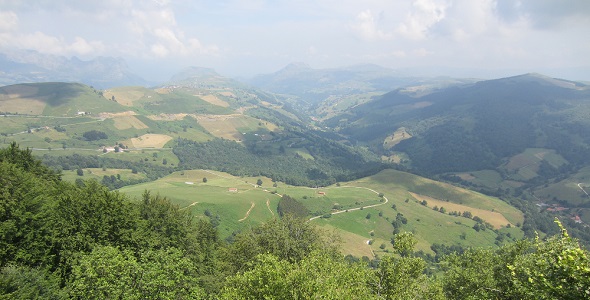
Economically, the traditional cattle rearing and dairy farming industries can no longer sustain the numbers of employees that it once did though these remain crucial to the region along with fishing and farming. Over the past half century tourism to the region has seen enormous expansion to the point where two thirds of Cantabria’s working population is now employed in the service sector with the majority living in and around the urban centres rather than the mountain villages.
A Brief History of Cantabria
The famous cave paintings of Altamira show that there were people living here at least 15,000 years ago and there is other evidence to support this. The Cantabrians were known to have given fierce resistance to the Roman occupiers of Hispania; the Romans never being able to do much more than rule the cities they had captured. When, in 409, Roman influence subsided, Cantabria was able to assert its independence until the Visigoths, in 574, under the leadership of King Lievigild, created the Duchy of Cantabria and used it as a frontier zone for their territory. As with the Roman occupation, though, many Cantabrians fled outside the controlled areas to continue to live their independent lives.
However, when a mixed Berber and Arab invasion force took over the Cantabrian capital city of Amaya, many local inhabitants joined forces with the neighbouring Kingdom of Asturias. One of the consequences of this became that, for many years, Cantabria lost its own political identity – being swallowed up and looked upon as just the coastal part of Castile. Although references to Cantabria remained, it was not until 1727 that there was an unsuccessful attempt to recreate the geographical unity of the region. What had become known as ‘the nine valleys’ became constituted as the Province of Cantabria in 1778, but there was still dispute about the official name as Santander, the capital, was continuing to insist in 1821 that its name should be used for the whole area. Just when it looked as if the old name of Cantabria was likely to be re-introduced formally again, the Civil War began, and at its conclusion Franco insisted that the area was to be known as the Province of Santander. It was not until 1982 that Cantabria became fully recognised as an autonomous community.
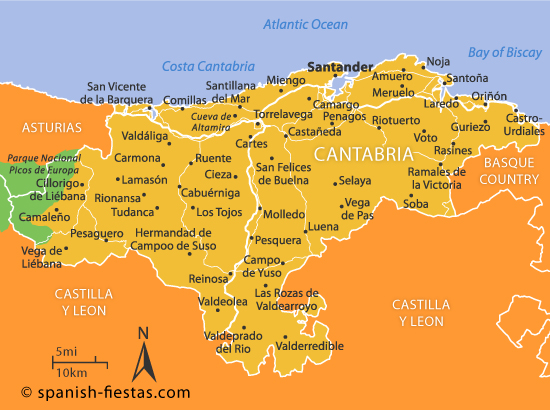
Getting There
The only International Airport in Cantabria is at Santander which only has a limited number of incoming flights from abroad. However, there are many connecting flights with Barcelona and Madrid for those wanting to fly from other parts of Spain, perhaps as a two-centre holiday. Thanks to the dramatic improvement in the road system across the north of Spain it’s now quite a straightforward journey from the airport at Bilbao, which is only an hour’s drive away to the west. Similarly, the journey to Asturias International Airport is easy enough. Many visitors now drive to the region travelling through France or arrive on a Britanny Ferries service to Santander or Bilbao from the UK.
The Spanish rail provider, RENFE, provides daily trains from Santander to Madrid, Oviedo and Bilbao as well as regional services to some of Cantabria’s lesser known destinations. There is also a picturesque tourist train running along the Cantabrian coast – in fact, it is possible to travel by train all the way from San Sebastian right the way across to Santiago de Compostela. As with most parts of Spain, there are frequent, efficient bus services between the major towns – and slower slightly less efficient services linking some of the more remote parts of the region.
When to Visit Cantabria
The region’s temperature has often been described as a humid oceanic climate, characterised by warm summers and mild winters. Some of the mountains in the Picos de Europa, though, experience an alpine climate, having snow for the major part of the year. The annual rainfall at the coast is around 1200mm, but, again, this is higher in the mountain areas. One interesting weather feature, especially in the autumn and winter months, is the microclimate caused on the coast by the ábrego wind, which can raise the temperature so that you get very pleasant warm and dry days throughout the year.
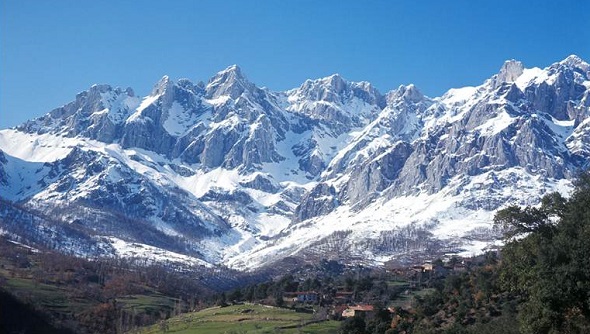
If you’re interested in paying a visit during a major festival then August is the month to be in Santander when the city hosts northern Spain’s equivalent of the Granada International Festival. Every venue in the city seems to be taken over for musical events of various kinds, from classical to jazz and flamenco to opera. Elsewhere, the night of San Juan is popular in many places throughout the country, but there is a special feeling to the event at Castro Urdiales. It’s another one of those fiestas that are not for the faint-hearted as one of the highlights is jumping over fires on the beach in order to burn away your problems! Santoña, in February, has the bizarre spectacle of the Carnaval Marinero, where most people wander around dressed up as fish, for reasons probably lost in the mists of time.
Main Tourist Attractions in Cantabria
The city of Santander is not only the capital of Cantabria but by far its largest town, with about 200,000 inhabitants. Although quite a modern city – an explosion in the 1890s and a fire in 1941 destroyed substantial areas – it has a pleasing atmosphere, best captured around its main beach, El Sardinero, and in some of the atmospheric restaurants in the centre.
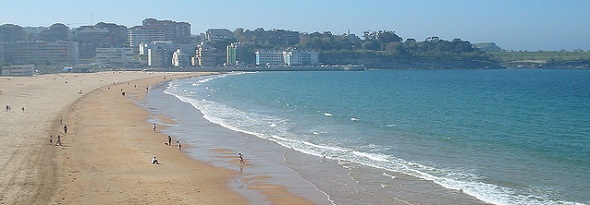
West of Santander
The prehistoric cave paintings at Altamira are the most famous attraction in Cantabria but visitors cannot see them nowadays as they are closed to the public since it was realised that they were being damaged by the carbon dioxide in the breath of vistors. Instead the ‘National Museum and Research Centre of Altamira‘ was set up which is an impressive museum which includes an authentic re-creation of the caves. Only academic groups get to see the original paintings these days with a waiting list of several years. As an alternative to Altamira you can head 25km south of Santander to Puente Viesgo which is home to the less well known Cuevas del Castillo which also display prehistoric cave paintings. Here you can see the original paintings and reservations can be made online.
Very close to Altamira is the wonderful cobbled town of Santillana del Mar which is one of the highlights of the towns along the Cantabrian coast. It is home to two parador hotels which serve as an ideal base from which to discover the area. Further west is Comillas which also has a lovely old town with some unexpected Gaudi architecture (El Capricho de Gaudí) and a fabulous beach. A personal favourite place to visit is San Vicente de la Barquera which is another 10km west which is a lovely old fishing port. If you approach via the coast road through the Parque Natural de Oyambre you’ll see some great beaches below you. I highly recommend the friendly, little Hotel Gerra Mayor which offers stunning views out to sea and inland towards the Picos de Europa though you’ll need a car to get into San Vicente.
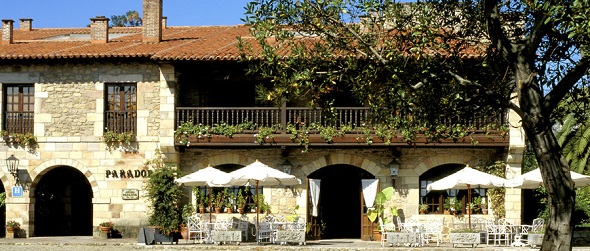
East of Santander
Heading east from Santander is far less impressive than heading west. It consists of holiday resorts of varying sizes which are popular in summer with visitors from Santander and Bilbao. Laredo has a nice old town, a fantastic beach and a lively nightlife which attracts plenty young people at weekends. We stayed at the excellent Camping Laredo from which you can walk to the ferry point which takes you over to the charming fishing port of Santoña which is well known for its anchovies.
Resorts further east including Islares and Oriñon have fantastic beaches but are very small so there’s limited accommodation and few places to go to in the evening. Castro Urdiales is the last stop before entering the Basque Country. It does have an attractive enough old town but the excessive property development surrounding the town ensure I won’t be heading there any time soon.
Inland Cantabria
To really fall in love with Cantabria you should get out your road map and find the green roads which lie inland from the coast. These roads will lead you to some quite stunning scenery where you can discover unspoilt villages and isolated hamlets. One of the best known drives from the coast to rural Cantabria is from San Vicente de la Barquera to Fuente Dé via Potes. There’s a modern parador at Fuente Dé if you fancy staying out in the countryside. Further east and some 65km from Santander there are some simply stunning sights in and around the Parque Natural Collados de Asón. We stayed in Laredo then drove to Ramales de la Victoria where we took a drive west to Val del Asón taking detours wherever we could find them. South west fo the park you’ll find some equally stunning scenery around the Purto de la Braguía pass.
Food and Drink in Cantabria
The beautiful scenery is just one of the attractions that draws me back to Cantabria time and time again. Another major factor is the fabulous gastronomical treats on offer in this region. With a coastline facing the Bay of Biscay, clearly fish is important in the culinary life of Cantabria but particular regional favourites are crabs, prawns, clams, crayfish and lobster. There is very good sea bass here and the locals love an anchovy sauce they make with olive oil and lemon juice and add to almost anything. They like their stews here too, especially Sorropotún, a stew of potatoes and tuna, and Cocido Montañés, a white bean, cabbage and meat stew. With fresh water fishing being popular, salmon, trout and, especially, eels are very common and tasty. There are also some excellent cheeses which come from the Cantabrian valleys and you can’t leave without trying a shot of orujo which is a particularly potent spirit which is a traditional drink of the region.

Hi Gerry
This is a really good article, thank you! We have friends in Vitoria-Gasteiz, so next time we visit the Basque region this will encourage us to venture into Cantabria.
Best rgds
Alex
Hi Alex
The scenery is really something special. You won’t regret it.
Best Regards
Gerry
I love this area. Clean, great food, beaches, and people. Much better than Basque area.
I’m also a fan of the Basque Country so prefer not to make comparisons. Both areas have a lot to offer the visitor.
Thanks
Gerry
Hi Gerry,
Very good article indeed, full of excellent and interesting information. This is an area of Spain that I have never visited before and I am now considering it for a future holiday.
Many Thanks,
Regards,
Heath.
Hi Heath
I’m sure you’ll enjoy Cantabria and its proximity to the Basque Country, Asturias and Castilla y León guarantees a wealth of places to see.
Best Regards
Gerry
You capture your tours around and bring them to life in my home, I love it!!
Look forward to the next. Thankyou. Nick
Thanks Nick
Such comments make it all worthwhile.
All the Best
Gerry
Hi Gerry,
Nice article on one of the few regions in Spain that we haven’t visited. You’ve tempted us!
Bill
Mission Accomplished 🙂
I wonder if the Cantabrian Tourist Authority will give me a job?
I’m sure you’ll the area Bill.
All the Best
Gerry
Great article.
We love Spain having holidayed there many times. Haven’t been to the Cantabrian region yet but after your article we will have to correct this.
Thanks for the insight into the area
Buenas dias,
I have not been to this part of Spain yet but your article makes me want to go Many thanks
Hallo !
I love Spain, but I haven’t been in this region until now. I hope next year I’ll be there!
All the Best
Madalina
Dear Gerry:
I’ve enjoyed these emails about a country I adore for so long now and it’s time for me to thank you for your wonderful and educational work. I’m so grateful to you for bringing parts of Spain to life that I have not yet seen, especially during the dreary Canadian winters.
With gratitude,
Lawrence
Thanks Lawrence … you’re very welcome.
Best Wishes
Gerry
I have been thinking of visiting this area for some time, so thanks for a great article!
Please note that Ryanair fly twice weekly from Edinburgh to Santander…..hence my
future plans!
Thanks Sheila